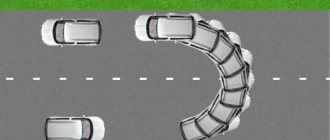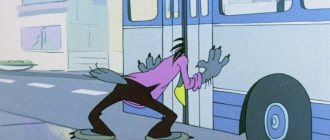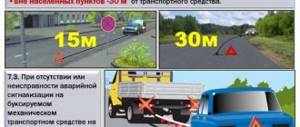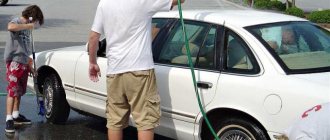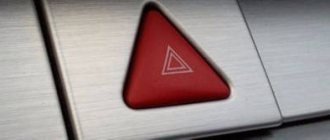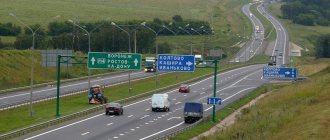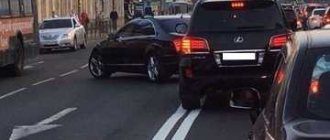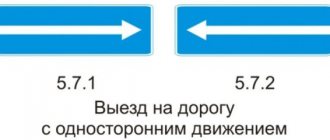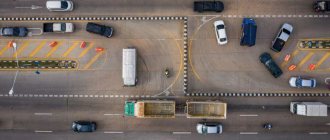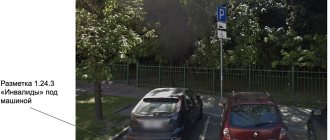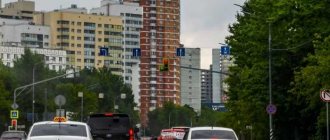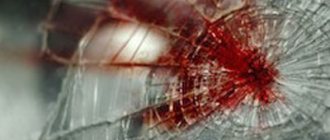In the comments to my articles here on Avtocel, I was repeatedly asked to talk about turning around on a road with a median. There is nothing complicated there.
But to fully describe turning, you must first understand how to turn left at intersections with a median.
First, let's remember. “Dividing strip” is a road element, distinguished structurally and (or) using markings 1.2.1, separating adjacent roadways and not intended for the movement and stopping of vehicles (clause 1.2 of the traffic rules).
Paragraph 8.6 of the traffic rules: “The turn must be carried out in such a way that when leaving the intersection of roadways, the vehicle does not end up on the side of oncoming traffic.”
If there is no dividing strip, then your left turn, shown in Figure No. 1, is fully consistent with traffic rules, and you will pass the oncoming car on the right side. No one forces you or the oncoming car to go around the center of the intersection. This mutual left turn is the safest, since the trajectories of vehicles do not intersect.
Likewise, if the dividing strip is located outside the boundaries of the intersection. At the intersection itself there is one intersection of roadways (Figure No. 2). An example of such an intersection is the intersection of Lenin Avenue and Engels Street.
If there is a dividing strip within the intersection (Figure No. 3), the road no longer has one, but two carriageways, and, therefore, at the intersection there are two intersections of carriageways (red rectangles in the figure). Therefore, going around the center of the intersection when turning left becomes mandatory - the driver should not find himself between two green lines when leaving the first intersection of roadways.
All these arguments are destroyed by the question: “How to drive through such an intersection if there are mandatory or prohibitory signs installed on it, which, according to the traffic rules, apply to the nearest intersection of roadways?” For example, ticket #15 question #2 (Figure #4) asks: “In which directions are you allowed to continue driving at the intersection?” The correct answer is “A and B.” Beyond the dividing strip the effect of the sign ends.
In addition, it is precisely this continuation of the boundaries of the roadway to the intersection that is shown in Figures B.7, B.10, B.11 in GOST R 52289-2004. A similar configuration is implied in the definition of an intersection in the Convention. Finally, this point of view was supported by the Supreme Court.
To prevent drivers from guessing and determining how many intersections of roadways there are at an intersection, and whether it is worth going around the center or not, a solid or double solid marking line is placed in the gap in the dividing strip (Figures No. 5 and No. 6). A detour is required.
Example - the intersection of Kaslinskaya and Brothers Kashirin streets - figure No. 7. Yes, yes, the intruder was caught in the frame. And for such a turn - a fine of 5,000 rubles or deprivation of the right to drive for a period of four to six months.
A reasonable question arises: “What trajectory should I take if the markings are erased?” For example, the intersection of Vorovskogo and Kurchatov streets - Figure No. 8.
Compare the diagrams of the two intersections again - Figure 9.
If the dividing strip is within the intersection (on the left) - we go around the center, outside the intersection (on the right) - it is not necessary to go around the center. Therefore, at the intersection of Vorovskogo and Kurchatov streets, when turning left, you cannot “mow the corner” even in the absence of markings.
It is no coincidence that traffic lights are highlighted in Figure No. 7. If they exist, then solid or double solid marking lines must be drawn.
In reality, with narrow dividing strips and no markings, many turn as shown in Figure No. 2. Such passage of the intersection is also enshrined in the regulatory documentation on traffic management. For example, Figure D.1 and D.3 “Instructions for marking highways” VSN 23-75.
If you are turning in the same way, in order to avoid conflict with inspectors when turning left, always drive as close as possible to the center of the intersection and pass on the right side of an oncoming car that is also turning left.
If the oncoming person decides to go around the center of the intersection, then you go around too. The order of passage is determined by the obstacle on the right - Figure No. 10.
At point A the red one gives way, at point B the yellow one gives way.
If there is no oncoming car turning left, then it is better to go around the center of any intersection - you will have a better view of oncoming traffic.
Traffic regulations operate with the concept of “edge of the intersecting roadway.” The edge itself is wide enough, since wheelchairs and pedestrians pushing a motorcycle can move along it - section 4 of the traffic rules. Consequently, the edges of the intersection of roadways are very, very arbitrary. From the definition of an intersection in clause 1.2 of the traffic rules it follows that the roadway and, accordingly, its edges at the intersection on one side are rounded, and on the other side the road together with the roadway goes straight.
Let’s say that for turning left at an intersection similar to the one shown in Figure No. 7, the inspector drew up a protocol for violating clause 8.6 of the traffic rules - in his opinion, you did not fit into the left turn too clearly. Subpoena an inspector and ask him to paint the wide, rounded edges of the roadway that runs straight through the intersection. It will be very interesting how it will look, since a real intersection of roadways has nothing in common with the established definition of the boundaries of roadway intersections in driving schools (see Figures No. 2 and No. 3).
Thus, the very concept of “intersection of roadways” is abstract, and do not try to determine the location of the edge of the crossed roadway with millimeter accuracy. As mentioned above, first of all it makes sense to determine the number of roadway intersections.
We will decide on the turning trajectory at intersections with a median in a week. In the meantime, look up what “right-hand traffic” means from clause 1.4 of the traffic rules?
The article uses materials and drawings from the “Lecture Notes for Driving Schools”.
Yuri Panchenko is known as the author of the book “Driver-Inspector. Conversation as Equals" (published jointly with the online community "Legal Literacy of Motorists") - a book that explains in an accessible form the nuances of the legal relations between police officers and ordinary motorists in our realities. Yuri is also a driving school teacher, a car lawyer, and produces illustrative materials to explain traffic rules.
You can ask questions about the topic of this article by leaving your comment at the bottom of the page.
The deputy general director of the Mustang driving school for academic work will answer you
Higher school teacher, candidate of technical sciences
Kuznetsov Yuri Alexandrovich
Quite often, drivers making a U-turn at an intersection are faced with the fact that they are accused of driving on the opposite side of the road and are deprived of their driver’s license on the basis of Part 4 of Article 12.15 of the Code of Administrative Offences. A non-existent violation leads to a very significant (and, most importantly, illegal) punishment, and therefore cannot leave indifferent drivers who are undeservedly deprived of their constitutional rights. Let's figure out which intersections are fraught with a hidden threat, what the driver can be accused of, and how certain points of the Road Traffic Rules should be interpreted.
In this case, only intersections with several crossings of roadways pose a danger.
Some traffic police officers classify a U-turn along the shortest path at such an intersection as driving along the roadway in the opposite direction. The absurdity of such a statement is very easily proven by a simple example using a one-way road intersection. A U-turn at such an intersection is not prohibited, and it is simply impossible to perform it without moving within the intersection towards the main flow, no matter what trajectory the driver chooses.
However, such a formulation of the violation is quite rare. Most often, the driver is accused of violating clause 8.6 of the Traffic Rules : “The turn must be made in such a way that when leaving the intersection of roadways, the vehicle does not end up on the opposite side.”
Paragraph 8.6 clearly states that we are talking about the TURN maneuver. And TURN and TURN are two different maneuvers. Requirements regarding turning are described in paragraph 8.11 of traffic rules.
However, understanding that they are trying to punish you unfairly and being able to prove it are, unfortunately, two different things. You can prove one thing, the traffic police officer another. To prevent the dispute about who knows the traffic rules better from dragging on indefinitely, you just need to turn to the governing documents. When considering cases related to driving into oncoming traffic, the judge must be guided by Resolution of the Plenum of the Supreme Court of the Russian Federation No. 18 of October 24, 2006 “On some issues that arise for courts when applying the Special Part of the Code of the Russian Federation on Administrative Offenses” (as amended , introduced by resolution of the Plenum of November 11, 2008 No. 23). Paragraph 12 of this resolution reads as follows: 12. Parts 3 and 4 of Article 12.15 of the Code of Administrative Offenses of the Russian Federation should qualify actions directly prohibited by traffic regulations that involve driving onto the side of the roadway intended for oncoming traffic.
The traffic rules directly establish such a ban in the following cases: a) on two-way roads with four or more lanes, it is prohibited to drive out to overtake, make a U-turn, or turn to the side of the road intended for oncoming traffic (clause 9.2 of the traffic rules). Such a prohibition must be indicated by road markings 1.3; b) on two-way roads with three lanes marked with markings, the middle of which is used for traffic in both directions, it is prohibited to drive into the leftmost lane intended for oncoming traffic (clause 9.3 of the traffic rules); c) overtaking is prohibited at signalized intersections with entry into oncoming traffic, as well as at uncontrolled intersections when driving on a road that is not the main one, with the exception of overtaking at roundabouts, overtaking two-wheeled vehicles without a side trailer and permitted overtaking on the right (paragraph second paragraph 11.5 of the traffic rules). Overtaking is also prohibited at the end of a rise and on other sections of roads with limited visibility when entering the lane of oncoming traffic (paragraph six of clause 11.5 of the traffic rules); d) it is prohibited to drive around vehicles standing in front of a railway crossing into oncoming traffic (paragraph eight of clause 15.3 of the Traffic Regulations); e) it is prohibited to drive onto tram tracks in the opposite direction. However, it is permitted to travel on tram tracks in the same direction, located on the left at the same level as the roadway, when all lanes in this direction are occupied, as well as when detouring, overtaking, turning left or turning around, taking into account clause 8.5 of the traffic rules, if this does not interfere with the tram ( clause 9.6 of the traffic rules). Violation by drivers of the requirements of road signs or markings, which resulted in driving onto the side of the roadway intended for oncoming traffic, should also be qualified under Part 3 or Part 4 of Article 12.15 of the Code of Administrative Offenses of the Russian Federation, since these norms are special in relation to Article 12.16 of the Code of Administrative Offenses of the Russian Federation.
Such situations may arise, for example, when driving on a road with one lane for each direction as a result of violation of the requirements of road signs: 3.20 “Overtaking is prohibited”, 3.22 “Overtaking of trucks is prohibited”, 5.11 “Road with a lane for route vehicles”, as well as road markings 1.1. Violation by the driver of the requirements of road sign 3.1 “Entry prohibited”, which resulted in driving in the opposite direction on a road intended for one-way traffic, must also be qualified as driving in violation of traffic rules on the side of the road intended for oncoming traffic. Thus, making a small-radius turn at intersections does not entail punishment in accordance with Article 12.15 of the Code of Administrative Offences, and it is unlawful to deprive a driver’s license for such a maneuver.
Of course, it is illegal and impossible, these are different concepts and our article will not save your driver’s license. But you can do this yourself, competently and convincingly proving to the traffic police officer that you are right. Conclusion: Learn the Rules of the Road.
You need their knowledge to drive safely. Read the full text of Resolution of the Plenum of the Supreme Court of the Russian Federation No. 18 of October 24, 2006 “On some issues that arise for courts when applying the Special Part of the Code of the Russian Federation on Administrative Offenses” (as amended by the Plenum Resolution of November 11, 2008 No. 23) you can on our website in the “Legislation” Section.
What does the traffic regulations say?
According to traffic rules, this maneuver is permitted. This is directly stated in paragraph 9.2. According to it, on four-lane (or more) roads it is prohibited to enter the oncoming lane to advance, but at the same time, U-turns and left turns can be made both at intersections and in other areas where this action is not prohibited by signs or markings.
This rule is indirectly confirmed by clause 8.8. According to it, when changing direction outside the intersection, the driver is obliged to let all cars and trams from the oncoming traffic pass. That is, the implementation of this action is possible if all conditions are met.
The rules state that when performing such a maneuver, the driver must position the vehicle in the extreme left lane, and if the roadway is not wide enough, use the right lanes and even the shoulder.
Based on the listed traffic rules requirements, a U-turn outside the intersection is permitted provided there are no restrictions from road markings and installed signs. Exceptions are places specified in the Rules.
Areas where this maneuver is strictly prohibited include:
- zebra crossings;
- tunnels and bridges;
- railway crossings;
- sections of the roadway with limited visibility;
- public transport stops;
- highways, outside areas specially equipped for this.
Is the intersection part of the road?
In the comments to the article » » readers assumed that the intersection is not part of the road, and therefore, the penalty of deprivation of rights cannot be applied for driving along a small trajectory.
This may have been the case before the rules changed, but the new one has changed this situation:
9.2.
On dual carriageway roads with four or more lanes, it is prohibited to overtake or pass into the lane intended for oncoming traffic. On such roads, left turns or U-turns may be made at intersections and in other places where this is not prohibited by the Rules, signs and (or) markings.
It is not entirely direct, but still states that the intersection is part of the road
.
What is the procedure for performing the maneuver
To change direction outside the intersection of roadways, the driver must ensure that the following conditions are present:
- Lack of a continuous marking line. Its presence indicates the impossibility of entering the oncoming lane.
- There is no “No U-Turn” road sign, or make sure that its coverage area has already ended.
- There is sufficient space to perform the maneuver. In this case, you can make a U-turn from any convenient point on the road, unless otherwise specified by markings or signs.
- Possibility of reversing. This option is acceptable on narrow roads, when even turning the steering wheel a full 180 degrees, it will not be possible to complete the maneuver. In such a situation, the driver can back up a little, free up space for maneuvering and complete the intended action.
After all the described conditions are assessed by the driver, he can take a comfortable position, let oncoming (and sometimes passing) traffic pass and perform a U-turn in one or more actions.
Where you can and cannot turn around
Even in the absence of prohibitory markings or road signs, maneuvering outside the intersection is strictly prohibited in the following areas:
- at a pedestrian crossing marked with a sign or zebra crossing. To perform the action you will have to drive 20-30 meters further;
- on sections of the roadway where visibility is limited. It can be affected by the presence of a sharp turn, bend or rise. As a rule, such places are marked with a corresponding sign;
- at a public transport stop. This means that you can make a U-turn only from the far left lane, without using the stop “pocket” for this;
- if there are signs “Move straight” or “Move right”;
- on all structures (bridges, overpasses, dams) and in the railway crossing area.
On all other sections of the roadway, outside intersections, changing direction is permitted.
How to turn around at an intersection
The ability to make a U-turn at a specific intersection is determined by the organization of travel at this intersection, namely: the direction of traffic along the lanes and the presence/absence of signs prohibiting a U-turn.
If you are driving on a two-way road and at an intersection from the leftmost lane signs 5.15.1 or 5.15.2 are allowed to turn left, and there is no sign 3.19 “No U-turn,” then a U-turn is allowed. It makes sense to remember that the prohibitory sign 3.18.2 “No left turn” does NOT prohibit a U-turn.
It is also necessary to pay attention to the possible presence of mandatory signs from group 4.1.1-4.1.6 at the intersection or in front of it. These signs indicate the mandatory direction of movement, their effect extends to the intersection in front of which they are installed. Signs from this group that allow a left turn (4.1.3, 4.1.5, 4.1.6) also allow a U-turn.
The traffic rules do not stipulate exactly how, i.e. what trajectory should a U-turn be taken at an intersection, but the Rules have clause 8.6, which reads:
The turn must be carried out in such a way that when leaving the intersection of roadways the vehicle does not end up on the side of oncoming traffic. The same rule applies to reversals.
Thus, if there is no dividing strip at the intersection, then you are allowed to turn around both short and long trajectories, but the turn at the intersection must be carried out within its boundaries.
If the turning arc extends beyond the boundaries of the intersection of roadways, then there is no violation. But you need to remember that entering the oncoming lane when it is separated by a solid marking line is prohibited (more on this below), and turning around is also prohibited at a pedestrian crossing (clause 8.11). Therefore, the turn line must be built without touching these road elements.
The figure below shows two intersections that have only one intersection (see the term intersection).
Any of the turning trajectories presented in the figures does not contradict the traffic rules, provided that the turn is performed within the boundaries of the intersection, and there are no signs prohibiting a turn, or other restrictions are not introduced prohibiting this maneuver.
For example, at an intersection there may be mandatory signs that prohibit turning left (including a U-turn), or signs with special instructions 5.15.1 “Direction of traffic along the lanes” or 5.15.2 “Directions of traffic along the lane”, which will also prohibit turn left (including a U-turn).
If the road being crossed has one-way traffic, then, again, you need to pay attention to the organization of passage of this intersection: the directions of traffic along the lanes, and whether there are signs prohibiting a U-turn.
In both pictures, turning left is prohibited, since traffic on the road being crossed is organized from left to right. But in the left picture, a U-turn is allowed, since there are no signs prohibiting this maneuver.
In the right picture, a turn is prohibited, since the sign 5.15.2 “Lane directions” above the left lane indicates a different direction of movement - it prohibits turning left and requires changing lanes to the right.
Now attention! An intersection that has two intersections of roadways. Those. one of its roads has a median. Dividing strips can be wide or narrow.
When the dividing strip has a straight cut, the intersection area is divided into two additional sections with opposite directions of traffic. These two sections can be separated from each other by a continuous marking line, but the markings may be erased over time.
On July 12, 2021, section 9 of the traffic rules was supplemented with clause 9.1 (1), which lists the conditions under which driving into the oncoming lane is prohibited. It is precisely the solid line that is mentioned in it. More details about this innovation can be found in the article Driving into the oncoming lane and clause 9.1 (1) of the traffic rules.
Therefore, if there is a need to turn around at an intersection, moving along a wide dividing strip, it is advisable to build the turning trajectory behind the center of the intersection, i.e. along a long arc. There are two reasons for this.
First. In our country, traffic is on the right hand side. Therefore, when moving within the boundaries of the intersection, you should keep the car as if in the “right half” of the roadway.
Second. The solid marking line may not be visible (erased, under the snow), but mandatory signs, as in the figure below, can be installed on the road intersected at this intersection. And this is a sign of the presence of a section of oncoming traffic between the boundaries of the dividing strip.
You can read more about turning at intersections of roads with dividing strips in a small series of articles U-turn at an intersection of roads with dividing strips, and in the article U-turning at an intersection with dividing strips and violation of clause 8.6 of the traffic rules.
If a city has a tram network, then it is quite logical that tram tracks also pass through intersections. You can read about how to make a U-turn across tram tracks in the article Driving through intersections with tram tracks.
U-turn at an intersection with a traffic light
If you have to turn your car at a signalized intersection (with a traffic light), then the turn is performed according to the same rules as turning left at a signalized intersection (see Rules for driving through intersections. Driving through signalized intersections):
- According to the rules for changing lanes, it is necessary to occupy the leftmost lane in advance, turning on the left turn signal;
- When the traffic light turns on, you move closer to the middle of the intersection. The front wheels must be kept in the “straight” position. You should not go further than the middle of the intersection. There will probably be a line behind you to turn left, and they don't yet know that you are about to turn around. Some drivers will try to take a shortcut under your “cover,” so when making a U-turn, always pay attention to what is happening to the left and behind you. As when turning left, you let oncoming traffic move “straight” through. If there are no oncoming cars, then you can turn around immediately as soon as you enter the intersection of roadways;
- After letting oncoming vehicles pass and making sure that you won’t disturb anyone, make a U-turn. If by that time the prohibiting signal has come on for you, then calmly complete the turn, since cars entering the intersection at the permissive signal from other directions are obliged to allow you to complete the maneuver. But in a situation like this you need to be extremely careful;
- You complete the turn, turn off the turn signal and continue along your route.
U-turn at an uncontrolled intersection
When you have to turn your car at an uncontrolled intersection, you must first determine exactly which road you are approaching the uncontrolled intersection on and who has priority in traffic.
How to determine the main and secondary roads can be read in the article Rules for driving through uncontrolled intersections.
If you are approaching an uncontrolled intersection on a secondary road and there is heavy traffic at the intersection, then it is better to abandon the U-turn and look for another place for it.
If you are approaching an uncontrolled intersection on a main road, then turning around follows the same rules as turning left at an uncontrolled intersection:
- First of all, before the maneuver, you need to make sure that no one is overtaking you - on two-lane roads at an uncontrolled intersection when driving on the main road, overtaking is allowed if there are no restrictions for this;
- According to the rules for changing lanes, occupy the leftmost lane in advance or, if the road is two-lane and the markings are not visible, press close to the middle of the road. Turn on the left turn signal, at the same time reduce your speed and drive closer to the middle of the intersection. If the road is clear, make a U-turn; if there is oncoming traffic, stop;
- You let vehicles move towards you on the main road and, after making sure that you will not disturb anyone, make a U-turn. Again, increased attention to the space behind your car - suddenly someone, turning left, under your cover, decided to cut the corner and does not realize that you are making a U-turn;
- Having completed the maneuver, turn off the turn signal and continue driving in the opposite direction.
U-turn at an equivalent intersection
An equivalent intersection is formed by roads of equal importance, most often not very wide. There are no priority signs before such an intersection, or sign 1.6 “Intersection of equivalent roads” will be installed at the approach to the intersection.
At an equivalent intersection, the so-called “interference on the right” rule applies (clause 13.11 of the traffic rules). You must give way to a vehicle approaching from the right. More details about this can be found in the article Interference on the right in traffic rules.
The rules and features of turning around at intersections of equivalent roads are described in detail in the article of the same name, U-turn at an equivalent intersection.
When a maneuver is prohibited by markings
A solid marking line or a double solid line clearly and unconditionally prohibits entering the oncoming lane. If it is present, the driver must drive to the section where it breaks or becomes intermittent.
It is also prohibited to make a U-turn outside of an intersection on roads with reversible traffic. In this case, line 1.9 is allowed to be crossed under the following conditions:
- The reverse traffic light is missing or turned off.
- The markings are located to the right of the driver.
But since crossing line 1.9, which separates flows moving in different directions, is prohibited, it will not be possible to make a U-turn on this section of the reversible road.
U-turn at a roundabout
Alternatively, you can use a roundabout to turn around. To do this, you will need to enter a roundabout, drive in a circle, following the rules for driving roundabouts, and take the required exit for traffic in the opposite direction.
You can read about driving through a roundabout in the series of articles “Navigating through intersections.”
Be careful while driving.
Article series navigation<< Performing a pivot. Part 1 When there is almost no visibility on the road >>
Prohibition signs
The main prohibitory sign in this case is “No U-turn” (3.19). It can be installed both on any section of the roadway and at the intersection of several roadways. Its location can be any - the right or left side of the road, a dividing strip.
A combination of this sign with information plate 8.1.1 is allowed. It indicates the distance through which the established ban will apply. An important nuance - the effect of sign 3.19 does not apply to public transport moving along the route established for it.
Other road signs prohibiting U-turns include:
- “Move straight” (4.1.1);
- "Move to the right" (4.1.2).
Also, prohibition signs include a combined road sign - “Move straight and to the right only.”
Penalty for making a U-turn in the wrong place
The Code of Administrative Offenses provides for punishment for violators of the rules regarding U-turns in the form of a fine in the amount of 500 to 1,500 rubles:
- For the absence of a sound signal from the driver performing a maneuver in conditions where his actions create a danger for other road users - a fine of 500 rubles.
- Turning from the right lane if it is possible to perform a similar maneuver from the far left lane - a fine of 500 rubles.
- Performing a maneuver in the presence of a prohibitory sign – 1000 rubles.
- Performing a maneuver when crossing a solid line, including on roads with reverse traffic – 1,500 rubles.
| Did not find an answer to your question? Call a lawyer! Moscow: +7 (499) 110-89-42 St. Petersburg: +7 (812) 385-56-34 Russia: +7 (499) 755-96-84 |
A U-turn outside an intersection is a maneuver permitted by the Traffic Rules. To carry it out, the driver must make sure that there are no prohibiting signs and markings , and also make every effort to ensure the safety of other road users.
Possible penalties
So, we have determined that turning around a smaller radius is a violation; now all that remains is to understand what punishment is provided for this maneuver.
It is necessary to find an article in which would provide for punishment for driving to the side of oncoming traffic when turning left or making a U-turn in violation of traffic rules. In this case, there are no additional violations of markings or road sign requirements.
No matter how strange it may be, only one article fits all the above requirements - part 4 of article 12.15:
Article 12.15.
Violation of the rules for positioning a vehicle on the roadway, passing oncoming traffic or overtaking
4.
Driving, in violation of the Traffic Rules, onto a lane intended for oncoming traffic, or onto tram tracks in the opposite direction, except for the cases provided for in Part 3 of this article -
entails deprivation of the right to drive vehicles for a period of four to six months
, and in the case of recording an administrative offense using special technical means operating automatically, having the functions of photography, filming, video recording, or means of photography, filming, video recording - the imposition of an administrative fine in the amount of five thousand rubles.
So the change in traffic rules and the Code of Administrative Offenses did not lead to a change in the penalties for the violation in question.
What possible options do you know for justifying travel on a short radius within the framework of traffic rules?
Paragraph 8.6 of the traffic rules talks about leaving the intersection of roadways. The carriageway (" - an element of the road intended for traffic. ") of each of the intersecting roads is ONE at the intersection, because There is no dividing strip at the intersection (“...separating adjacent roadways.”). The road has two adjacent carriageways only where there is a dividing strip. And where the dividing strip ends or is interrupted (including at an intersection), the road has ONE carriageway. Accordingly, only where a dividing strip appears (including behind an intersection, which, by the way, does not always happen) does the road again have two adjacent carriageways. Proof: Please note that the definition of “Intersection” states that the roadways have “curves”, i.e. their edges are rounded (and do not continue with imaginary lines further through the intersection, as incorrectly suggested in interpretations of traffic rules and in driving schools). It is easy to understand that, upon reaching the intersection, the edges of two adjacent roadways (bordering the dividing strip) are rounded and closed, and the two roadways merge into ONE roadway. Accordingly, at the intersection there is only ONE INTERSECTION OF DRIVEWAYS.
